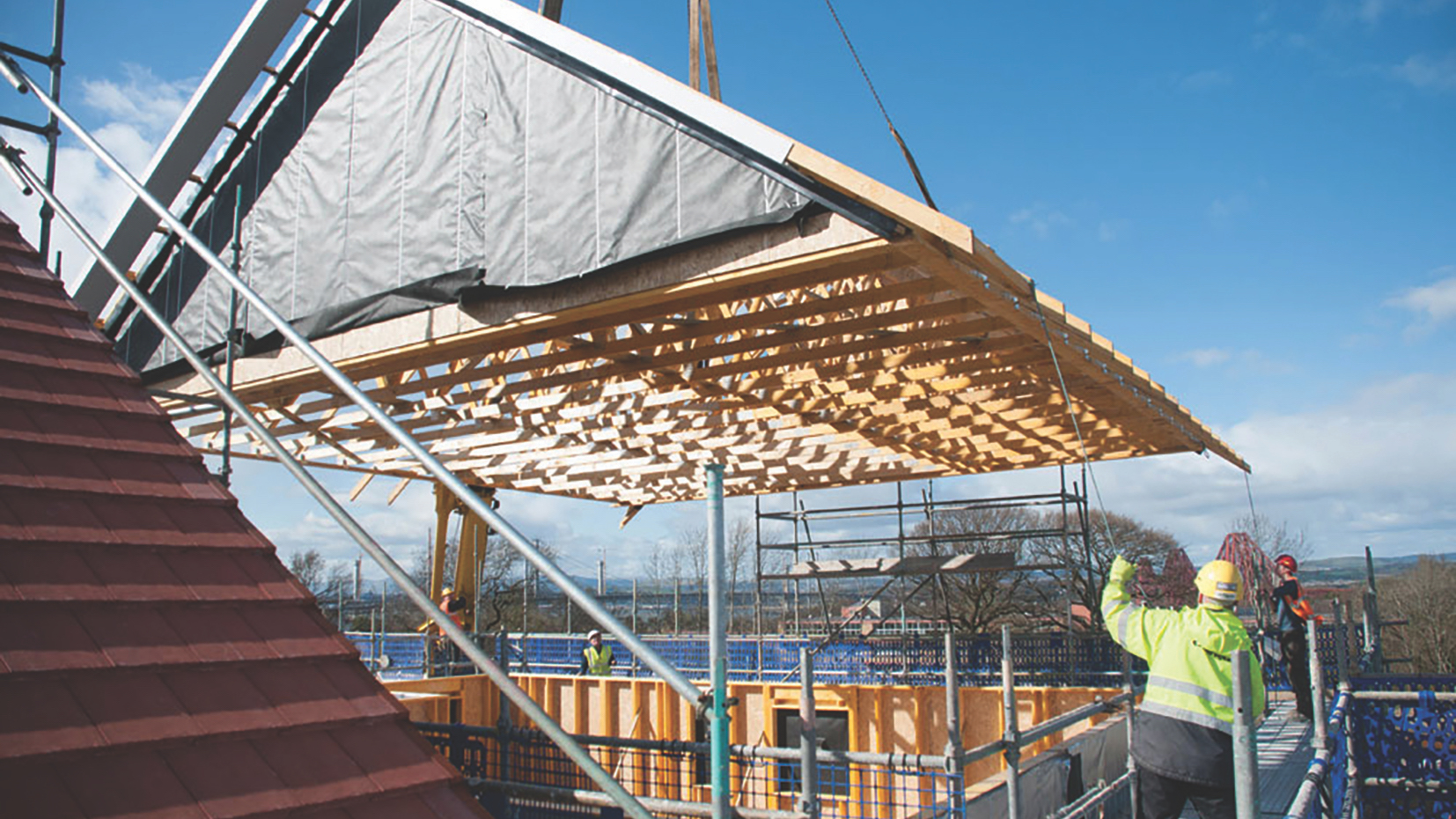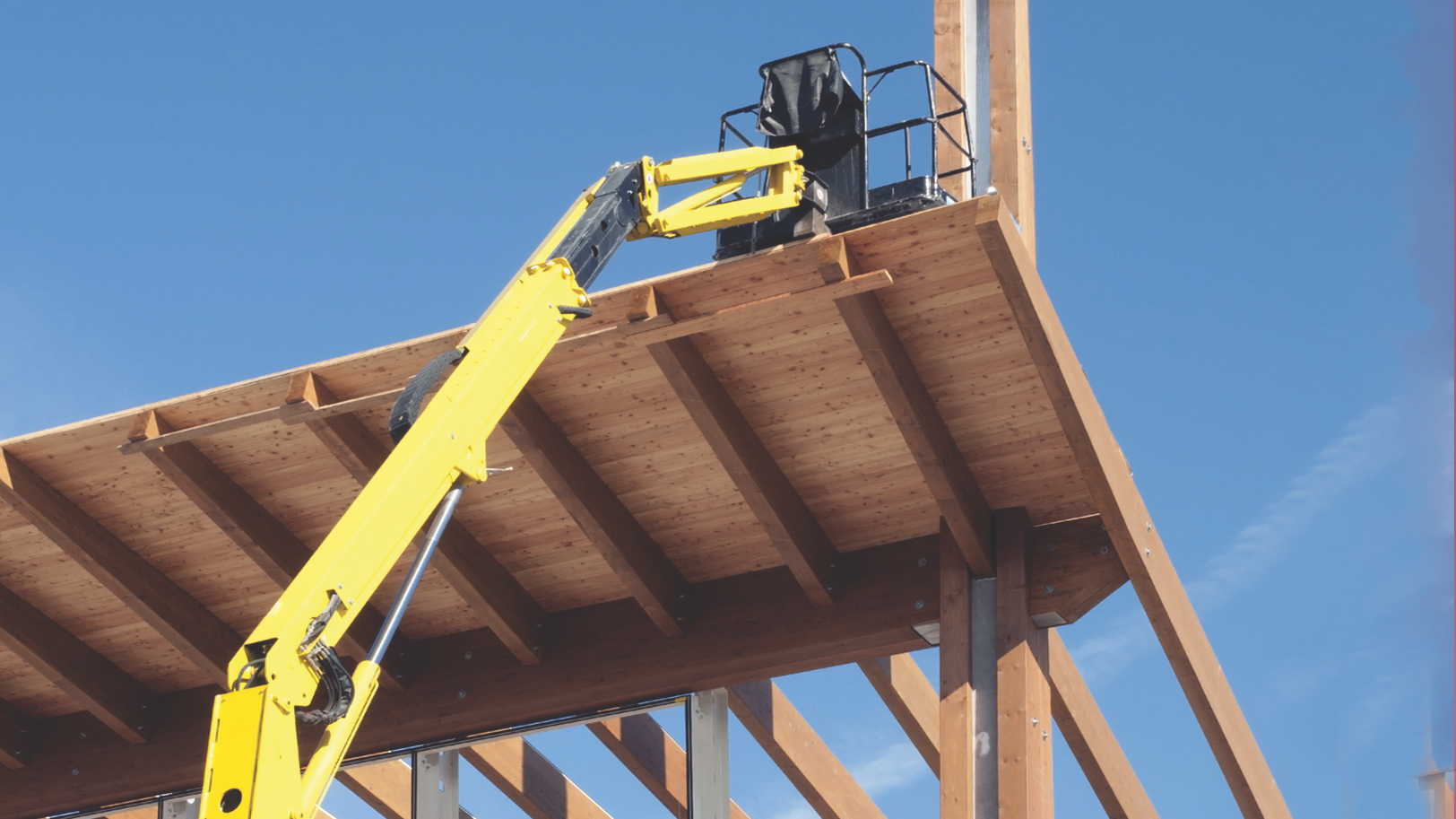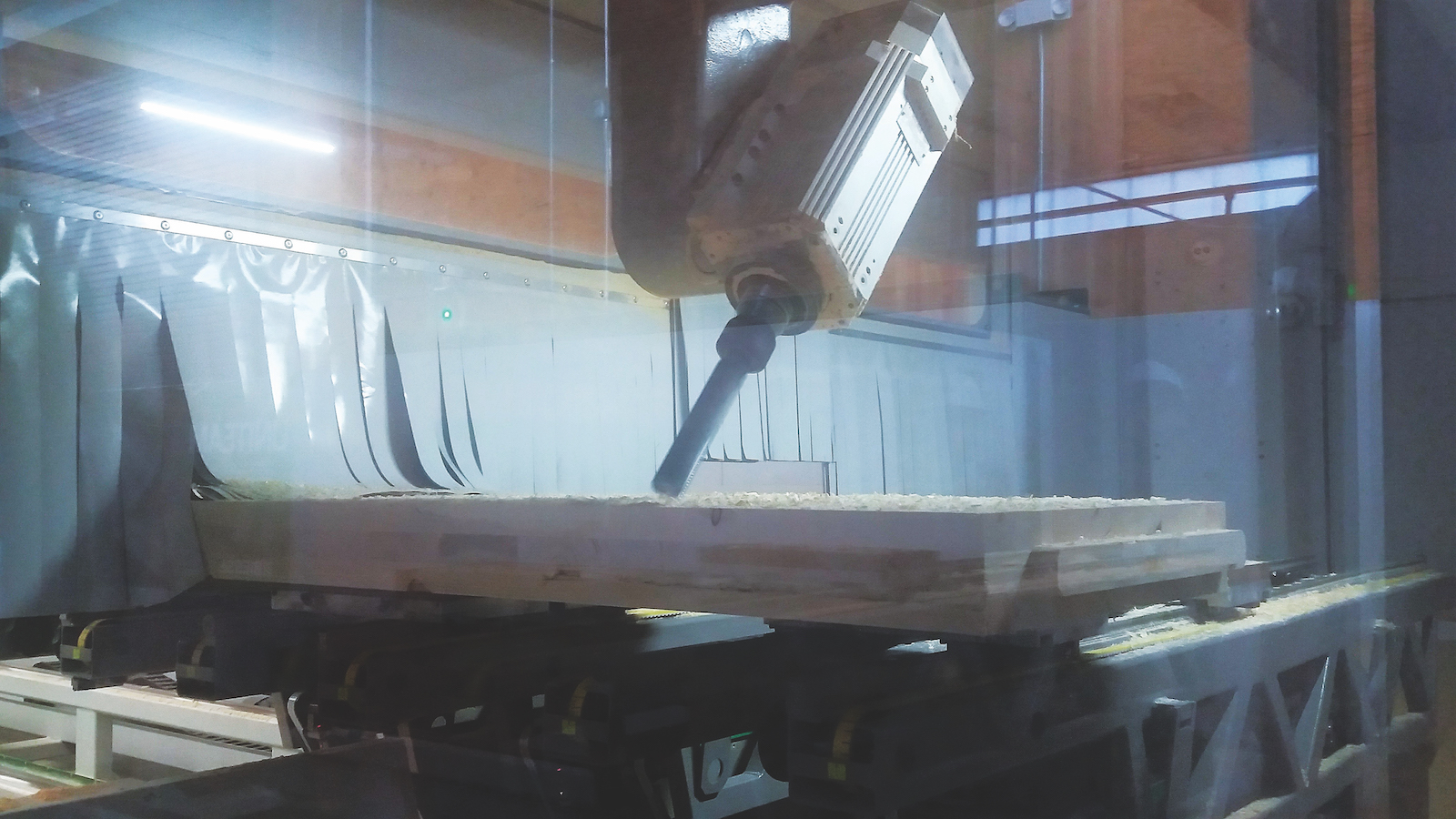Carbon reduction, offsite manufacturing, wellbeing, local sourcing – timber answers many of UK construction’s most pressing questions. But when will the sector start, er, pulling up trees? By Kristina Smith

It feels a bit like Groundhog Day. In October 2000, the Wood for Good campaign launched, with its message about the environmental benefits of using timber more widely in construction. Twenty years later, it is still trying to get that message across.
“We wanted to go back to basics and communicate with a variety of audiences,” explains Wood for Good’s campaign manager Sarah Virgo of the body’s ‘Wood CO2ts less’ campaign, which was launched last summer. “It focuses on the entire cycle, the fact that we need sustainably managed forests because they help suck up all the CO2 from the atmosphere and store it.”
With the government’s pressing emissions reductions targets, its so-called ‘Green Industrial Revolution’, and its instructions to count whole-life carbon in its new procurement guide, The Construction Playbook, Wood for Good should be pushing at an open door. But it isn’t. There seem to be too many opposing forces at the other side of the door: concerns over fire performance, interests of other materials manufacturers and an unwillingness to force change on commercial housebuilders.

“We need sustainably managed forests because they help suck up all the CO2 from the atmosphere and store it”
“Government legislation has held innovating with timber back,” says Tabitha Binding, university and regional engagement manager at the Timber Trade Federation
(TTF). “It’s not that we cannot do it; the problem is that there’s no drive to do it without the legislation and regulation we need.”
Nevertheless, there have been some significant changes in the way we use timber in our buildings since Wood for Good was created. The use of structural engineered timber such as CLT (cross-laminated timber), nail-laminated timber (NLT) and glue-laminated timber (GLT or glulam) has come on in leaps and bounds. This is timber, but not as we knew it – modified so that its properties are enhanced and uniform, offering new possibilities for design and construction.
Locking up carbon
As well as mass-engineered timber, there has also been an increase in engineered timber for applications such as doors, windows and other joinery. Engineered timber of all types enhances the environmental good news story, explains Ewa Bazydlo, environmental manager at timber product supplier James Latham Group.

Take Accoya, for instance. It is made from treating fast-growing pine trees that take around 30 years to reach maturity, yet Accoya has a lifespan of 60 years.
Home-grown homes
Research projects in Scotland and Wales aim to encourage the use of home-grown timber for housing construction.
Wales’ Home-Grown Homes Project published an in-depth report about its findings in December 2020 after nearly three years of work. Led by Powys County Council, its output is a raft of tools and guidance on everything from designing for net-zero whole-life carbon to building a Welsh wood economy to fighting negative perceptions.
In Scotland, a consortium is manufacturing the first Scottish-sourced cross-laminated timber (CLT) and nail-laminated timber (NLT), using the UK’s only vacuum press at the Construction Scotland Innovation Centre (CSIC) facility in Hamilton.
The CLT and NLT will be used to create the superstructure for a house to be showcased at the COP26 United Nations conference on climate change, which will be held in Glasgow in November.
Researchers from the Scottish project say that their home-grown solution could reduce capital cost by up to 10% – as well as reducing carbon emissions by reducing transportation costs.
Engineered timbers, such as Thermowood or Latham’s WoodEx, have other benefits too. Because they don’t have the variations that natural timber does, there is less waste; you don’t have to throw away the knotty bit. “They increase the technical performance of the product, the lifespan and the durability,” says Bazydlo. “They are also more stable, and easy to work with.”
One downside to this good-news story is that most engineered timber is imported to the UK from northern Europe – which means we are losing out nationally on those carbon sequestration benefits that come from growing our building materials. Two research projects in Scotland are demonstrating how we can work with home-grown timber (see box, below).

“Engineered timber of all types enhances the environmental good news story”
James Latham Group
“Although there will always be a place for imports, there really is a big market opportunity, particularly for CLT,” says Virgo.
To create locally engineered timber products requires long-term vision, says Dr Antiopi Koronaki, a research associate at the University of Cambridge’s Centre for Natural Material Innovation.
“We need to be careful and strategic about what type of trees we plant,” says Koronaki, who is researching the use of digitally delivered engineered timber for schools (see box, right). “We need to be sure that we can get the engineered products we need and that the trees we plant contribute to the biodiversity of the forest.”
Her project aims to demonstrate how we could deliver even more value from engineered timber by using manufacturing techniques that link logistics, design, manufacture and assembly. The proposition is that schools would cost less to deliver, less to run, emit less carbon, boost the UK manufacturing sector – and boost the wellbeing of our kids.
New timber generation
New materials, such as engineered timber, require new skill sets. “When you use timber, you really need to understand its properties to get the best from it,” says Binding. “You need to understand what product to use where.”
Binding works with universities, lecturers and students to educate them about the challenges of designing with wood. Though traditionally it has not been part of the curriculum, universities including Anglia Ruskin, Cambridge and Edinburgh Napier are now including timber on their courses.


“When you use timber, you really need to understand its properties to get the best from it”
Timber Trade Federation
The TTF with the Timber Research and Development Association (TRADA) also holds an annual interdisciplinary competition for students. This year’s competition, which was launched at the beginning of February, asks the students to design housing for Riverside Sunderland to create a carbon neutral quarter; more than 150 students from 25 universities have enrolled.
Multi-disciplinary teams are vital for efficient design and delivery in timber, says Binding: “My real plea is that construction is seen as a skilled industry, where people understand building risks and complexity.”

Force for change
There was disappointment, when the government published its response to the Future Homes Standard consultation in January this year, that it had ignored the many calls for embodied carbon to be included.
Fire still a hot topic
Fire safety remains thorny issue for the timber sector
Following the Hackitt review into the Grenfell tragedy, the government banned combustible materials in any part of an external wall above 18m, not just cladding, which means structural wood is out.
It could get worse: the current Combustible Materials review – government response yet to be published – could lower that to 11m.
Many in the industry are calling for a more intelligent approach. “Rather than banning one aspect, we should really be looking at all the different aspects that we can add or take away from a building,” says Sarah Virgo.
There is lots of testing and research work underway to help us better understand timber and fire safety, which is vital, says Dr Antiopi Koronaki. “Timber construction can provide fire protection – amendments to current regulations are necessary to focus the ban of combustible materials on cladding panels above 18m only and make a clear distinction between cladding and primary structure.”
While the government fails to join up the dots between climate change, embodied carbon and building materials, some built environment professionals are taking matters into their own hands. Organisations such as the Architects’ Climate Action Network (ACAN) and the London Energy Transformation Initiative (LETI) are campaigning and creating guidance to precipitate change.
There is force from shareholders and investors too. Housebuilder Barratt set itself demanding carbon reduction targets, including embodied carbon, in April last year.
Then there’s the growing business of carbon offsetting, used by Barratt and many others to help reach their corporate carbon neutral goals. Forestry group BSW launched CarbonStore in September last year where landowners can market woodland carbon and businesses can buy it.
Virgo suggests housing associations or housebuilders could even invest in forests which they could later build homes in.
It feels like the forces pushing on that timber door are gaining in number and in strength. How much longer will the government keep it closed?
Digitally designed timber schools
Cambridge University’s Centre for Natural Material Innovation is devising a blueprint for the delivery of engineered timber school buildings.
The thought of sending our children to school in a building dominated by timber, rather than concrete and steel, will seem appealing to many. And probably unrealistic. With the huge number of schools needed, the current mood is that buildings must be cost effective and utilitarian.
With engineered timber you can have it all, says Dr Antiopi Koronaki,
a research associate at the University of Cambridge’s Centre for Natural Material Innovation.

“You don’t have to choose between a high quality, healthy environment and utility and cost efficiency”
“You don’t have to choose between a high quality, healthy environment and utility and cost efficiency,” she says. “Modern construction methods and engineered timber can address both of these challenges.”
Koronaki is researching how precision-engineered timber and digital design and delivery can lead to healthier schools. The three-year project, which is around halfway through, aims to look at the changes to procurement and policy that would be needed, as well as technical issues.
“Our aim is to develop a set of school designs and a means of fabricating them,” says Koronaki, an architect-engineer who specialises in fabrication.
The project is led by Dr Michael H Ramage and Koronaki’s collaborators include Dr Darshil U Shah, Dr Aurimas Bukauskas and Ana Gatóo. The research forms part of the Centre for Digital Built Britain’s (CDBB) work at the University of Cambridge within the Construction Innovation Hub (CIH). The CIH is funded by UK Research and Innovation through the Industrial Strategy Challenge Fund.

Delivering schools in this way at scale would require a more collaborative approach which involves architects, engineers and digital fabrication specialists.
It would also need new skill sets, says Koronaki: “For the broad application of engineered timber construction, the government may also have a role to play in funding and coordinating with industry bodies to deliver skills training programmes for workers across the supply chain.”
Engineers, architects and others need to understand how the engineered timber panels and components are used, how to design connections and what the construction sequence will be. It’s vital to consider logistics: for instance, the size of CLT panels, how they will be transported and how they can be most efficiently manufactured into building components.
“It’s important to develop methods that recognise the different stakeholders and allow them to collaborate from Day Zero,” says Koronaki. “It requires more coordination early on. The costs shift to the beginning of the project, but they are fixed earlier, you reduce the risk and any contingencies and it’s easier to assign risk to the right stakeholders.”
The project will also be working closely with policymakers to try and make changes there. “While there is knowledge on how to build schools using timber in the UK, there is a lack of incentives and policies for timber to be used more widely,” says Koronaki.











